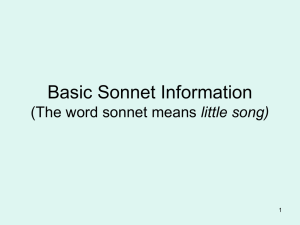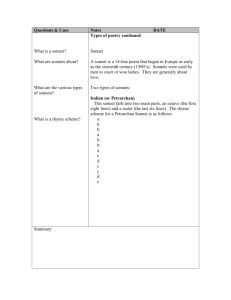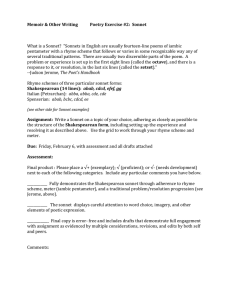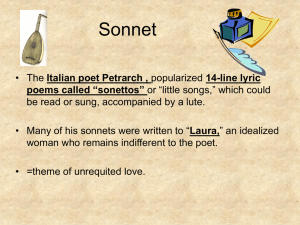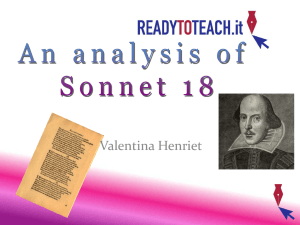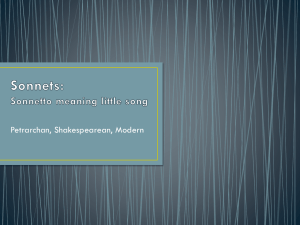Sonnets
advertisement
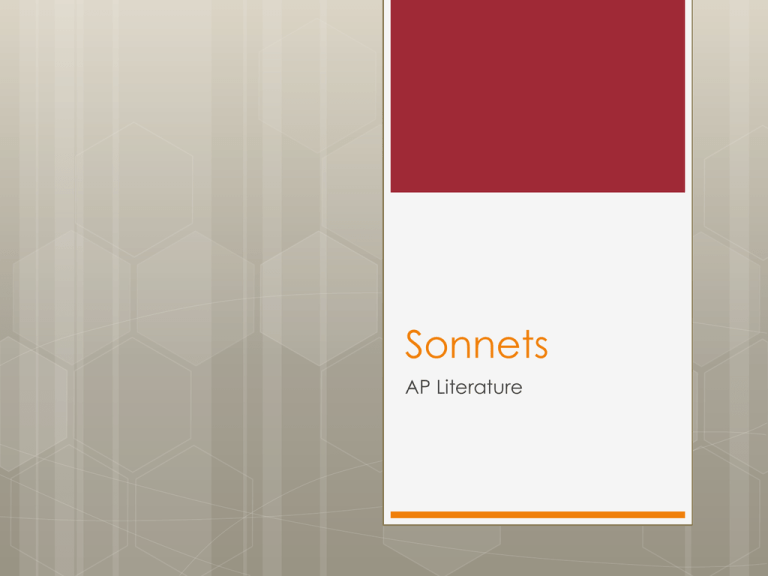
Sonnets AP Literature Characteristics of a Sonnet There are two general types of sonnet: Petrarchan or Italian Shakespearean of English Sonnets have 14 lines, which is the first thing you should look for. The rhyme scheme is what determines what type of sonnet it is, so you look at the rhyme scheme to identify. Rhyme Scheme Italian Sonnets tend to have an end rhyme that concludes with: ababababcdecde (some variations of that appear) Shakespearean Sonnets will always end in a rhyming couplet (two lines). If you look at the rhyming pattern, but ends with that couplet, then it’s Shakespearean or Elizabethan! Form—Iambic Pentameter Sonnets are written in iambic pentameter, which means: 10 syllables per line Five pairs of alternating unstressed and stressed syllables The rhythm in each line sounds like: ba-BUM / ba-BUM / ba-BUM / ba-BUM / baBUM Characteristics (cont) Sonnets are generally about love, religion, politics, or about a theme. Sonnets are not usually “story” poems. Some poets play with the form of the sonnet and place them in their longer poems to highlight the form and themes of the sonnet inside their poem (see Mathew Arnold’s “Dover Beach” for internal sonnet in his poem) Sonnet 43 by Elizabeth Browning How do I love thee? Let me count the ways. I love thee to the depth and breadth and height My soul can reach, when feeling out of sight For the ends of Being and ideal Grace. I love thee to the level of everyday's Most quiet need, by sun and candle-light. I love thee freely, as men strive for Right; I love thee purely, as they turn from Praise. I love thee with a passion put to use In my old griefs, and with my childhood's faith. I love thee with a love I seemed to lose With my lost saints, --- I love thee with the breath, Smiles, tears, of all my life! --- and, if God choose, I shall but love thee better after death. Sonnet 116 by William Shakespeare Let me not to the marriage of true minds Admit impediments. Love is not love Which alters when it alteration finds, Or bends with the remover to remove: O no! it is an ever-fixed mark That looks on tempests and is never shaken; It is the star to every wandering bark, Whose worth's unknown, although his height be taken. Love's not Time's fool, though rosy lips and cheeks Within his bending sickle's compass come: Love alters not with his brief hours and weeks, But bears it out even to the edge of doom. If this be error and upon me proved, I never writ, nor no man ever loved. Sonnet Recap…How Can You Tell Does it have 14 lines? Does it have an easy rhyme scheme that gives it a rhythm? Does it end with a rhyming couplet? If so…it’s easy to tell it’s a Shakespearean or English Sonnet! Why does it matter? Sonnets use iambic pentameter and have themes to them, not stories.
